Coal Mines
Coal has always been a major cargo for the railways, many lines were built specifically to carry the stuff and in the early years of the twenty first century it remains a major source of revenue. The proportion of coal used for domestic heating had dropped steadily, notably after the introduction of North Sea Gas in the 1970s (which was sold off very cheaply). North sea gas also eliminated the flows of coal to gas works but coal remains a major fuel in electrical power generation.
Outline History
The coal mining industry peaked in 1913 when there were over two and a half thousand coal mines in Britain. Welsh steam coal was used by the South American railways and by (British built) steam engines powering the industrialisation of countries around the world. The First World War caused the foreign customers to seek alternatives and the cost recovering coal from the deep British mines resulted in a general reduction in production.
In 1913 the railways moved over 226 million tons of coal, by 1922 this had fallen to 222 million tons, this dropped to 194 million tons in the mid 1920's then picked up again, reaching 207 million tons in 1929. The hard times of the 1930's and the shift to the convenience of gas fires in the home all reduced coal usage but when the coal mines were nationalised in 1947 there were still over four hundred and fifty deep mines in operation. Mines after this date would have any internal vehicles clearly marked NCB (National Coal Board). The illustration below is based on a photo in an NCB leaflet, note the size of the boiler chimney.
Fig ___ British coal mine photographed in about1950
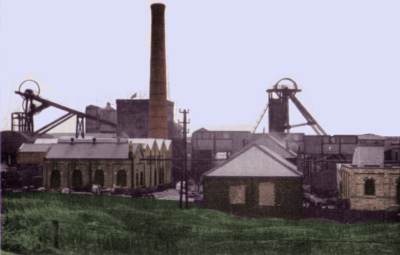
The large number of ancilliary buildings housed the stores and workshops for the electrians, welders, pipe fitters and engineers, a mine of this size would probably have their own forge and foundry to maintain the coal tubs and other equipment used in the mine.
Pit closures continued as the easily accessible coal was mined out and during the 1960's unrest developed among the miners. There was a national coal strike in 1972 and another in 1974 which had a greater impact as the power stations had used up their stockpiles and power cuts had to be introduced.
In spite of all the closures there were still two hundred and forty seven working British pits employing over 200,000 people in the mid 1970's. The advent of cheap oil fired heating, replaced in turn by North Sea Gas and the popularity of gas and electric heating systems in the home have all reduced demand until by the early 1980's rail movement amounted to about 80 million tons per year.
The coal strike in 1984/85, the subsequent change to gas firing by many power stations and the ending of the 'Network Coal' domestic coal services meant that by the early 1990's rail moved only about 30 million tons per year, mainly in MGR trains. British Coal was privatised in December of 1994 and by the end of 1995 there were less than thirty pits, only two being deep coal mines, left in operation.
Coal Mine Operations and Structures
There are many variations on the coal mine theme, a lot depends on the type of coal being recovered, how much coal is in the seam and how deeply buried it is. In some mines, large and small, the coal was recovered with very little unwanted material mixed in to it and could be sold direct from the skip. This is called 'run of mine' coal, naturally mines which offered this type of coal were the first to be exploited and the first to be exhausted. By the 1990's run of mine coal was associated mainly with small mines often of the 'drift' type operated by small companies with perhaps a staff of three or four men.
Mined coal needs to be graded for most applications, the smallest grade is dust, sometimes used by power stations, next comes 'slack' comprising dust with pieces up to about 2cm long by 1cm thick. Next up in size is 'smalls' but the most useful size in Nuts, required for making coke and popular for house coals (usually mixed with slack to give 'nutty slack'). The bigger lumps are called cobbles.
The coal is first graded by passing it over screens, first heavy punched steel sheets are used to separate the cobbles, then lighter screens remove successively finer grades until the final stage is usually a fine wire mesh. The large lumps are passed to conveyor belts or rotating circular tables where staff pick out the similar sized rocks by hand, conveyors were first made from old rope in the 1880's. The smaller sizes (less than a five inch (12cm) cube) are passed to a washery, these appeared at about the same time as the conveyor picking belts. Coal washing is a system which uses an agitated bath of water to separate the coal, which floats, from the dirt and rock, which do not. The graders, picking tables and washeries were enclosed in a large building, usually positioned at a higher level than the railway loading tracks. The graded coal was passed into the loading hoppers inside an adjacent building, usually at a lower level than the main building, and with a series of railway tracks passing underneath. Domestic users want coal in the range one inch cube to four inches cube (25mm cube to 100mm cube) and this size fetches the most money. Anything larger was usually shipped out in the wagon to be broken up by the coal merchant (who was then stuck with the resulting low-value dust).
Steam boilers and 'producer gas' generators were designed to use the low-value small stuff from about an inch cube (25mm cube) down to dust but a mix of this with some larger lumps was usually supplied. Gas works used coal graded from about 8 inches cube down to dust and electricity generating stations took small sizes, a mix called Rough Slack consisting of three inch cubes down to dust being most common.
Naturally there was quite a lot of small coal and dust produced at the mine. This had little value as coal but it could be mixed with coal tar pitch and pressed into 'briquettes'. This is not a new idea, briquetted coal was an important commodity from the mid nineteenth century until the introduction of the Clean Air Acts of the 1950's. Scott of the Antarctic took coal with him briquetted into one foot cubes (30cm cubes) in XXX. These could be used to build shelters until required as fuel. The dust and small coal could also be used to make coke which can be sold or ground up and formed into briquettes as above (this is smokeless fuel, see below).
Fine coal dust, called variously 'slack', 'smudge' or 'duff' was recovered at the mine in various ways. Freshly mined coal could be passed on a conveyor over an up-draught of air which blew the dust up into a tall conical silk sack in a structure resembling an American water tower. Periodically this was emptied into wagons for delivery, the wagons being sheeted over to prevent the dust blowing out in transit. This air-blown technique was routinely used to separate out the fine coal from the stone and rubble in the Kentish mines where the coal was friable and not suited to washing with water. This was called 'dry cleaning'.
With the introduction of coal washing in the 1880's the mines produced a lot of 'slurry' which was deposited in settling pits. Here the stone and sand sank to the bottom whilst the coal floated to the top. The slurry dried out leaving a segregated layer of coal sitting on top of unwanted gangue materials. This was periodically emptied and the fine coal was piled up to dry properly (sometimes being heated). The resulting coal powder was sold, shipped in sheeted open wagons or in special hopper wagons. Associated with this process was a curious inverted cone shaped structure, the 'slurry tower', which was a characteristic feature of modern mines from the mid 1930's to the present day.
Fig ___ Washing Cone
Coal dust was used for a range of processes, in greater quantities than the mines could recover, so it was also made by deliberately crushing coal. This was usually done at the receiving end rather than at the mine. The coal dust was shipped in sheeted open wagons or in wagons with a pitched roof (called 'cottage topped' wagons), one major application was in cement manufacture where the coal dust was blown into the rotary kiln.
A lot of coal is in thin seams, restricting the use of mechanical aids and requiring the miners to remove a lot of unwanted material to make room to work. Coal mines have been operated where the seam itself was perhaps only a foot thick and the miners hacked out the seam by hand in this narrow space.
Coal seams are often fractured by fault lines, where this was severe there was a lot of digging involved to re-join the seam when the fault line was reached. This restricted the quantity of coal that could be recovered and hence the size of mine that could be operated. Mines with these problems might have justified a railway siding up to the 1930's but after that a remote loading arrangement as described above would be the norm. Often these mines are operated only because the coal they produce is very clean and so does not require the complicated washing and processing described above. Mines with these problems would probably not justify much in the way of equipment and would usually be operated as drift mines however there were some very small shaft type mines selling run-of-mine coal with minimal surface processing.
When the mines were nationalised in 1948 the National Coal Board found working the very small mines uneconomical but they granted licences to independent operators to run them, subject to the strict national regulations and regular inspection by the mine inspectorate. Up to the 1990's there have been a number of very small independent drift mines operating in the coalfields, most notably in South Wales. Many of these small drift mines are usefully compact and can be included on a layout relatively easily although they would be unlikely to have a rail connection after the mid 1960's. Adrian Booth of the Industrial Railway Society has produced an excellent book on these mines, for details see the Bibliography. These mines offer considerable scope for detailing, old BR van bodies were widely used for stores and even as stables for the pit horses and one had an old lorry with its wheels removed acting as the winch engine for the cables pulling the mine tubs.
Fig ___ British Drift Mines
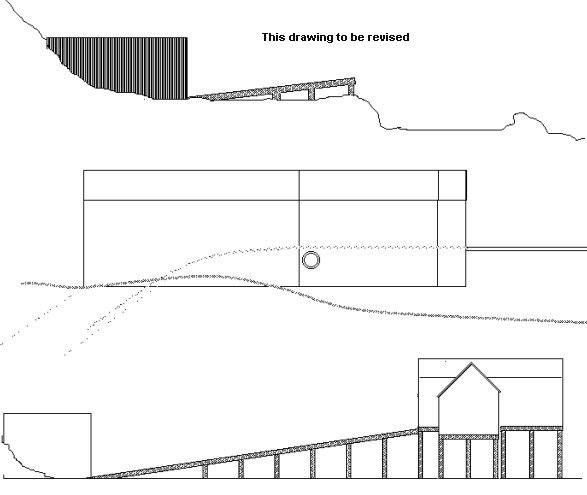
Not all drift type mines were small, some were very large indeed. In several larger mines the drift entrance was used for lifting out the coal, either in tubs or on a conveyor system, and a shaft was used as the secondary entrance.
Pola do a splendidly dilapidated wooden 'coal mine' (Item 245) this is for a 'drift' type mine and is intended to be added to a hillside but it has been used as part of a home-made shaft type mine built on the side of a hill. The sketch below shows a mine that could be represented using the Pola kit for the screens over the track. The sketch is based on a British mine in Staffordshire photographed in about 1900. The sketch is a simplified version of the prototype, on which there were at least two wooden screen buildings over the tracks and a separate boilerhouse and chimney. The elevated track to the left leads to the spoil tip. Note the blocks between the rails under the screens, supporting a wire cable used for moving the wagons under the screens and returning them to be collected by a loco (note with the screens so low the loco cannot pass underneath them to collect wagons, on a model layout it is a better idea to have clearance under the screens for the engine). There are a total of four tracks passing under the screen, two under the higher section to the right, two more under the lower section on the left.
Fig ___ British coal mine incorporating Pola kit parts
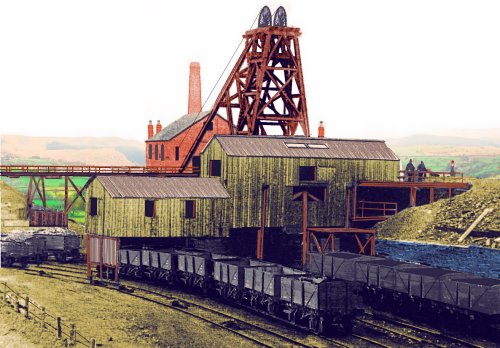
This mine would suit a corner location, with the loading sidings curved round following the main line track. Adding exchange sidings at the junction with the main line would add a lot of real estate to the mine but if it had say just three tracks under the screens with another two outside them you could get away with a simple headshunt. The railway company engine could deposit a rake in one siding and collect a loaded rake from the other with a small pit engine shunting wagons under the screens as required.
The structure supporting the winding wheels above a mine shaft is called the 'head stock' or 'pit head' and the basic design remained essentially the same for over a hundred years. Up to the late 1930's small mines often used timber for the gantry supporting the winding wheels, good quality 'pitch pine' was used (see also under Timber Yards).
Fig ___ Timber pit head gear c1939
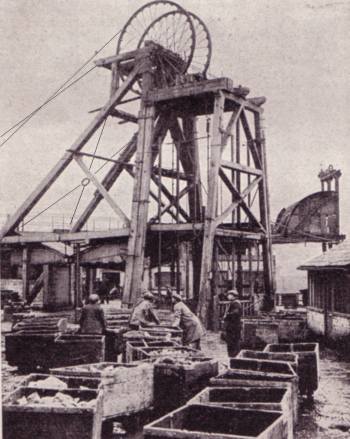
Most larger mines switched to steel in the early part of the century and for the bigger structures it was common to use box sections of trussed steel. This is not really practical from a modelling perspective unless you are prepared to spend the money and have an etching made to order but fortunately the smaller pit heads of the type more likely to be of interest were made from H and I section girder. The Plastruct 'fine' range includes suitable H and I section strip for building the tower, cross bracing and gussets can be made from 10 thou card or microstrip. Wooden pit head towers remained in use however, even at quite large coal mines. The Caphouse colliery in Yorkshire, now part of the Yorkshire Mining Museum has a wooden pit head and this was in use until 1979. The example below is an all metal pit head sketched from a preserved example at Washington in County Durham and dating from the mid 1920s. The lattice legs can be represented using Ratio OO scale LNER signal masts, the rectangular frame in which the cars operate can be Plastruct H section. By opting for electric winding you do not need the boiler house and chimney for the winding house. When the mine was in use there would have been a structure enclosing the base of the pit head tower but this may have been some distance from the picking sheds and screens, connected by narrow gauge colliery lines carrying the tubs direct from the mine. Note I have slightly simplified the structure of the pit head gear but nothing essential is missing.
Fig ___ Simple pit head gear with electric winding house

Note there are usually two winding wheels on the pit head, this would be the norm for all but the smallest mines. Single wheels were seen but these would only apply in a relatively shallow mine, for deeper mines it makes sense to widen the shaft so that two cages can be accommodated. This allows the weight of the loaded cage being pulled up to be part balanced by the empty cage going down.
The pit head gear at the Washington mine was the most simple structure I was able to identify, most were rather more complex, the photo below shows a particularly fine example made in OO by Simon Weston, he even went to the trouble to produce the winding wheels with the spokes reaching down to alternate sides of the hub.
Fig ___ British style pit-head winding tower
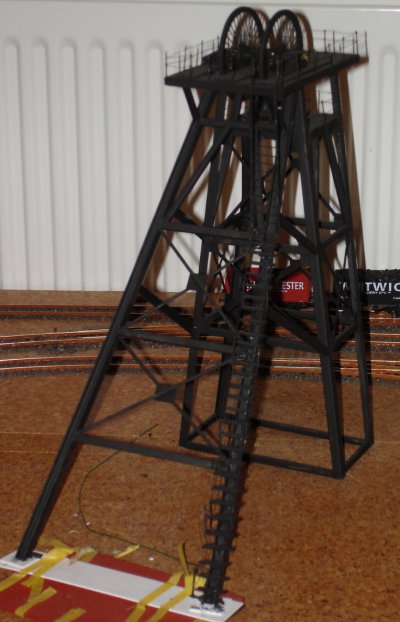
Model made by Simon Weston, image courtesy and copyright Simon Weston.
In a modern colliery, equipped since the mid 1960's, the pit head gear is encased in a concrete tower called a Keope tower. This is the easy option for the modeller, a block of wood 2" x 1" par (20 mm by 45 mm) and a minimum of about five inches (120 mm) high would serve. Note how the tower has a sideways extension at the top, this should be about one inch high and half an inch thick.
There is no British 'pit head' (the tower with the wheels on top) produced in N as far as I am aware, however Faller do offer a continental pit-head in their range (2190). A better option however is to build the frame from plastic section or strip wood and add the 'wheels' from spoked OO bogie or tender wheels with the flanges filed off.
The sketch below shows a small shaft mine dating from the latter part of the nineteenth century, essentially similar small mines were still operating certainly into the 1960's, although few boasted a direct rail connection. The sketch gives some indication of the room required for even a small mine, consisting of only a simple pit-head structure, winding house, and raised runway for unloading the coal tubs into railway wagons on the adjoining siding. This sketch is based on several mines, the pit head gear is from a photograph taken in the 1890's in Staffordshire and the raised runway enabling easy loading of railway wagons and tipping of 'spoil' was a feature of a mine in Nottingham. Not many mines were so simple, the example shown assumes a good thick seam of coal which required no further screening on the surface (so called 'run of mine coal'), these did exist but they are the exception rather than the rule.
Fig ___ Small Coal Mine as built in the 1890's (suitable for use up to the 1930s)
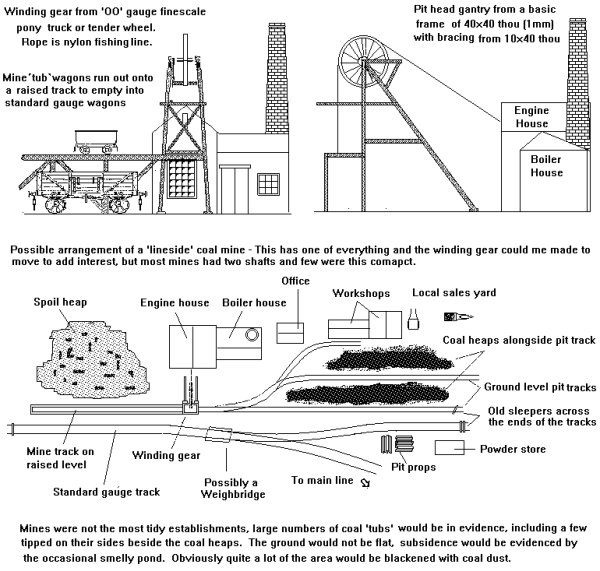
One building not included on the above example is the wash-house. An Act of 1911 stated that coal mines had to provide on-site showers for the men, the coal mine owners objected and a clause was inserted that said this would only be a requirement where the majority of miners wanted it. The majority of miners did want showers at the pit head so any model of a decent sized mine after about the First World War should have a shower block. The wash house was often called a 'mine dry' as the miners washed themselves and their clothes there and usually left their work clothes to dry.
Having said all of which my mother lived in Wigan in the 1920s and remembers the miners from a local pit walking home at about 2 in the afternoon, all with black skin and red rimmed eyes.
Where the coal seam was thick the size of the mine increased and where the coal was deep a thick seam would justify the use of a shaft with its associated winding gear. Mechanical coal cutting is comparatively recent, at the time of the First World War over ninety percent of coal mined was being dug out by hand. In medium to large mines it was usually to load the railway wagons from over-track buildings attached to the mine itself. I would suggest at least four sidings passing under the screens or washery and there would usually be a couple of storage sidings as well.
Most mines, after the turn of the Century, had the base of the pit-head enclosed in a large structure of some form which often included the grading and loading arrangement. The drawings below are based on photographs of various mines featuring the enclosed pit head.
Note how the wagon loading extension is always lower than the main building, in the upper wooden structure (based on a preserved mine at the Beamish open air museum) this is only just high enough to clear the coal wagons, a normal height locomotive can not pass underneath. If you wish you can raise things a bit to allow standard size locomotives access but this is not necessary if the sidings dead-end. I have shown only two sidings, which is the absolute minimum, four would be more realistic.
The mine in the upper sketch below has both a shaft and a drift entrance (leading up to the picking belts via the incline. The picking belts and screens are raised above the tracks on wooden supports. Another option, which adds some scenic interest to the site, is to have the sidings leading to the loading area running down into a cutting. This was not common in larger mines with many sidings but there were quite a few smaller establishments with perhaps four loading tracks where this was done. The lower sketch shows such a mine, based on a prototype at Poynton in Cheshire, which had just four sidings as shown. This arrangement might also facilitate the lead-through of the sidings to a fiddle yard or hidden return loop to achieve the empties-inwards-loaded-out wagon flow.
Fig ___ Enclosed pit head drift and shaft mines
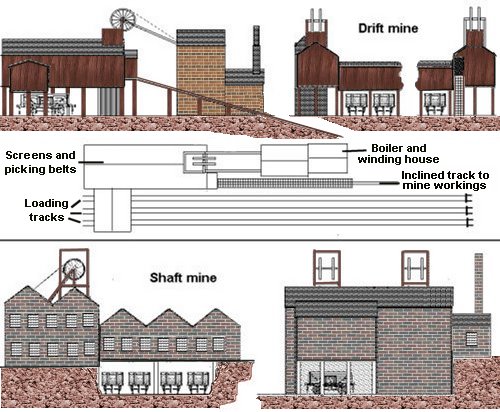
A typical medium sized coal mine might send out two trains a day of between thirty and a hundred wooden wagon loads, or more recently between fifteen and thirty HEA hopper wagons. Typical MGR trains are between 30 and 45 HAA/HDA wagons but these are usually loaded at dedicated loading points with massive over-track bunkers and usually some distance from the mine itself.
Larger mines such as those once found in the Welsh Valleys (the last of which closed in the late 1980's) had extensive siding accommodation for wagons. The buildings were commonly built on raised pilings with the sidings passing underneath (remember you cannot run a siding through where the shaft itself would fall!). Mines of this size would have the full range of ancillary buildings and structures and would have their own internal use rolling stock and locomotives. A full size mine of this type would require a large chunk of real estate on the average model railway but could form the basis of a self contained layout in their own right. Railway company locomotives seldom wandered into these large collieries, small tank engines owned by the mine would be used internally and wagons tripped to and from a set of 'exchange sidings'. These exchange sidings would be alongside the main railway line and the track to the mine could extend for several miles.
Fig ___ British Large coal mine

The larger coal fields all had several collieries and with mergers and acquisitions it was not uncommon for several pits to share some facilities, for example some mines shipped their tubs of coal on special flat bed railway wagons to a central grader or washery. Although not common practice this does mean you do not have to build the pit-head as such.
Internal use only wagons did not have to conform to the railway loading gauge and there were some quite interesting designs. The wagon with a mixture of dumb and sprung buffers illustrated in Fig ___ (Vol 1. Rolling Stock Design, Buffers) makes for something rather different and larger vehicles used to carry tubs of coal sported features such as a rear mounted brake-man's cab, popular on the continent but not used on main line railways in this country.
The sketches below show a selection of such internal user colliery wagons with livery details. The wagon conveying coal tubs is sketched from a photograph dated 1910 in Michael Ware's book 'Canals & Waterways' (details in the bibliography). The photograph showed such wagons carrying coal tubs to the canal wharf to be tipped into the barges but they were also used to carry coal from smaller pits to a central screen or washery. The transporter wagon is an internal use only vehicle, note the dumb buffers, these were still technically legal in 1910 but would be rare on the main railway system.
You could substitute a railway siding for the canal wharf, the tubs would carry coal from the screens to be tipped into standard railway wagons. This arrangement would have been rare however as it was easier to load the railway wagons at the screens direct. The original barge loading areas appear to have been covered with simple arched corrugated roofing and for this the Ratio corrugated roof would serve well.
Fig ___ British Colliery wagons
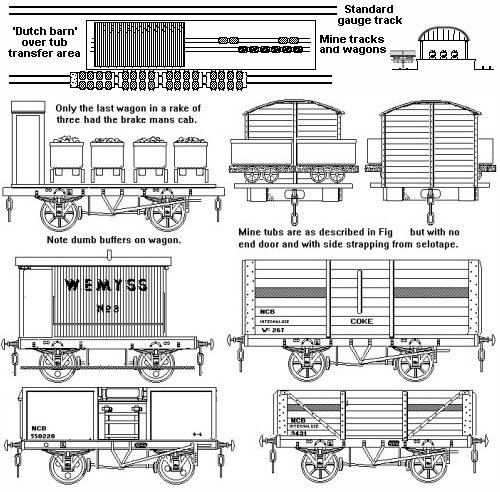
Flat wagons loaded with coal tubs were sometimes hauled long distances on the main line railways, in one instance in the 1950's a fleet of twenty four-wheeled flat wagons carrying loaded coal tubs was sent from a mine in Wales to Birkenhead.
In the North East there were electrically hauled railway systems, owned and operated by the coal mines and subsequently British coal, which continued operating to the end of the 1980's. These locomotives used overhead catenary wire pick-up with pantographs on the locomotives. Although there were many different designs of loco there were all if the double-ended centre-cab type. The pick up pantograph could be mounted on the roof (Fig ___A) of if the loco was required to pass under the loaders it might be mounted on the bonnet (Fig ___ B). In some colliery lines the clearances at level crossings was particularly generous, require larger than usual pantographs, Fig ___ C shows a loco with very long arms in place of a pantograph.
If you want something a little different but do not want to build the catenary there were battery locomotives used and an example is sketched in Fig ___ D. This would technically be a difficult item to motorise in N but an alternative approach would be to add a colliery brake van or stores van with the chassis replaced with a motor bogie (Graham Farish). This means you can use a lengthened Graham Farish coach bogie for the chassis of the loco.
Both suggested chassis only have a single coupling at one end so they would need to be permanently coupled with a wire link (Fig ___ E). There is comparatively little detail work required on the loco, looking at Fig ___ F we have a rectangular panel about 20 thou thick on top of each bonnet (a), there is a siren or hooter (b) on the cab from with a centrally mounted headlight (c) and note the extra pair of square buffers (d) for handling chaldron wagons.
Fig ___ British Colliery Electric Loco's
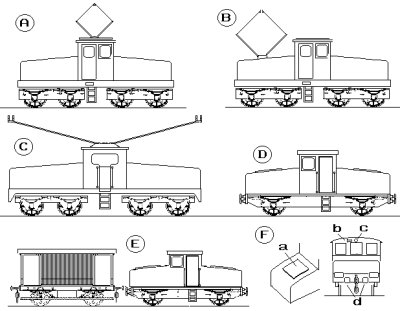
One electrified colliery line, which operated into the 1980's ran from Westoe Colliery to staithes at Harton near Jarrow. In its later years the colliery owned a fleet of ex BR unfitted 21 ton hoppers. These wagons were painted red, some were marked NCB in the upper left and HARTON in the upper right in lettering about eight inches high, others were in plain bauxite with small lettering in the lower left and a few were marked LAMBTON COKE WORKS in eight inch high lettering in the upper part of the three side bays. The locomotives used were similar to those in Fig ___ (B), they were painted black with NCB in white, eight inches high, on the sides of each bonnet. Operations on this particular line ended in 1989, and for the last few years they were moving spoil rather than coal.
If you want a working electric locomotive the Ready-To-Run model by Arnold (West German class 169, catalogue number 2402) is a four wheeled type, the model is about 54mm long and close enough in appearance to the British types to pass muster. If you do not wish to install an overhead wire simply remove the pantograph (you will need to replace the roof with card) and it can represent one of the battery locomotives.
In other establishments the coal was carried from the washery to a wagon loading hopper via a covered conveyor arrangement. This is one of the easiest to represent although a little care is required disguising the disappearance of the conveyor into the scenery. Conveyor systems were convenient and hence common where the mine was located close to a power station. The first mine opened by the National Coal Board was Lee Hall colliery near Rugley in North Staffordshire, opened in 1960 it fed a power station via conveyor (due to geological problems the mine closed in 1991). Some of these conveyors systems carried coal from one pit to a 'washery' at a second mine and then on to the power station, a cumulative distance of several miles.
Modern coal loading depots and collieries often simply have piles of graded coal, which is loaded into railway wagons, or road transport, using mechanical shovels. Some of these have a raised platform for the shovel to operate on, giving better visibility for the driver. This is known as 'pad' loading and the concrete pad of a typical installation would be getting on for two feet or sixty centimetres long in 'N'. The coal stockpiles backing onto the pad area would be supplied from conveyor belts feeding chutes mounted on swinging arms. This is a relatively attractive option for the modeller as it can be run against the back-scene with the colliery represented by a painted scene or using pictures cut from magazines.
MGR hoppers are loaded in this way in some locations as this arrangement costs less than a tall loading hopper fed by conveyor belt, the hoppers have an additional disadvantage in that many were built too low to clear the side extensions on the HAA/HDA wagons. Remember that a full size MGR train would have forty or so wagons, which is about eight foot or two and a half metres long in "N', but a rake of twenty wagons looks acceptable.
As noted above there is a always weigh-bridge on the track leading out from a coal loading point, be it hopper or mechanical shovel. At the MGR loading points if a wagon is found to be over loaded a mobile crane fitted with a small grab is used to off-load some of the coal. The office for the weigh-bridge is often set into the ground, so the staff can check that all the bottom doors on the wagons are closed.
The layout suggestion at the bottom shows a two-track loading hopper which allows full and empty trains to run into and out of the fiddle yard.
Fig ___ Modern MGR loading facilities
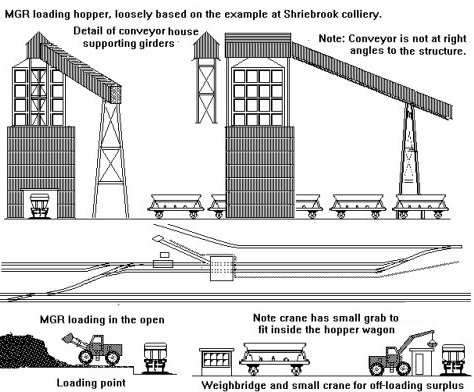
Incoming traffic to a mine would include pit props (discussed in more detail in the cargo and wagon loads section), quantities of limestone dust (particularly in coal mines) shipped in sheeted PO wagons, explosives in 'Gunpowder vans' or more recently in VDA vans, van loads of tools and open wagons for larger pieces of machinery and equipment.
One problem for the mines was disposing of the unwanted material from the mine, this was piled up in 'slag heaps', which often grew to truly enormous size. To get the waste to these one common option (at least by the 1930s) was the overhead ropeway. The example below is from a National Coal Board leaflet and was photographed in the later 1950s, sketched at the side are the tipping skips carried on the cables. Note the concrete coal washing cone visible between the suspended skips and the large number of mineral wagons in the sidings to the left and right.
Fig ___ British coal mine spoil conveyor photographed later 1950s
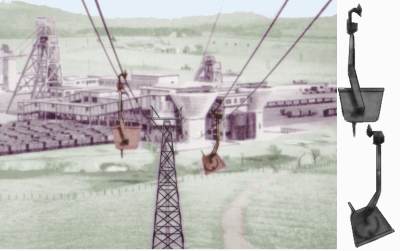
British Coal Fields
There are many kinds of coal, in Ireland they recover peat from the surface, this is not actually coal but it would be if left for a few million years. In Europe, but fortunately not in Britain, there are extensive reserves of poor quality 'brown coal' or Lignite close to the surface. Deeper down you find the better quality bituminous 'house coal', deeper still and you find harder 'steam coal' which produces little smoke but gives a lot of heat. At the deepest levels you get the very hard anthracite, which is almost pure carbon and burns very hot with almost no smoke at all. In Britain there are extensive coal deposits, in many cases geological activity had brought the good quality coal (usually associated with deeper seams) close to the surface. In Wigan at the start of the industrial revolution there were seams of good quality coal up to seven feet thick exposed on the surface. Britain has a mining tradition going back thousands of years and as the easier deposits were worked out shafts were sunk to access the deeper seams of coal.
There are a number of coal fields in Britain, each of which has its associated industries grouped round it.
Fig ___ British Coal Fields

Northumberland & Durham.
This field dates back as far as the fourteenth century when coal was mined for shipping to London (known as 'sea coal') and as recently as the 1960's over fifteen million tons a year was shipped by sea from this field to British ports, still mainly those on the Thames. Nearly all the ports in this area handle coal, Blyth, the Tyne ports, Seaham, Sunderland and the Hartlepools. As iron and steel replaced wood for ship building the area became important for its shipyards, rivalling the Clyde. This field boasted good 'steam coal' in the north and high quality coking coal in the south of the coal field, regarded as the best in Britain. This is used to make coke for steel works and as a smokeless fuel, it was important in the development of the iron smelting industry which grew up near Middlesborough after the 1850's. The contraction in the British steel industry caused a reduction in output and by the mid 1990's there was only a single coke plant in operation near Jarrow in the North East. There were iron and steel industries were based in this area, hence the coke works. To the south of the coal filed lies Middlesborough where iron and steel industries were established in the mid nineteenth century using iron ore from Eston Moor and the Cleveland Hills. As these were worked out the ports established to export coal handled imported ore and scrap metal. By the 1960's there was only one small ore field being worked in the area but ore from Northamptonshire and Cumberland was brought in by rail. Limestone was of course available from the Pennines and the ports allowed the manufactured goods to be exported or shipped along the coast. Salt is also mined near Middlesborough and after the second word war the anhydrite deposits were exploited to make sulphur for sulphuric acid (the anhydrite works at Billingham was taking in over five hundred tons of coal a day by the late 1950's). Oil refining has become increasingly important, by the 1960's this had allowed the development of a large ICI chemicals plant producing polythene, synthetic rubber and synthetic textile fibres from the refinery by-products.
Cumberland
This small coal field lies on the coast and the workings extend for some miles under the sea. Most of the coal recovered was exported through the ports of Maryport, Workington and Whitehaven, most going to other British ports. The coal in this field was not of the best quality, it was mainly mined for use as 'house coal'. Although it was used for iron smelting in the Workington area (using ore from Egremont and Cleator Moor) it was not good enough quality to be used in the important iron and steel industry based on the hematite deposits in the Furness area.
York, Derby & Nottingham
This is the largest coal field in Britain about seventy miles long by twenty wide from the Aire Valley in the north almost as far south as the Trent. By the 1940's this field was producing over thirty percent of all British coal.
The high quality of the coal and the nature of the seams meant that it was worth sinking pits in Eastern Nottinghamshire, these were often very deep (eg 2,670 feet at Thorne) and from the 1940's this progressively changed the nature of formerly rural Nottinghamshire with a major development around Doncaster. Coal from this field allowed the development of iron and steel manufacturing at Scunthorpe, the area south of Lincoln and around Grantham. Because of the poor quality of the 'Jurassic' ore the coal was normally carried to the area of the iron mines after the 1930's. There is a wagon shown in Fig ___ associated with this coal field and operated by a firm based in Sheffield who supplied most of the major gas works in the country. There is a great range of industry based on this coal field, the iron and steel industries around Sheffield lie in the centre of the field whilst to the north is the woollen industry of the West Riding of Yorkshire. To the south there is a range of smaller industries associated in the main with hosiery made from cotton, silk and wool and the famous lace making industry in the Mansfield-Derby-Nottingham area.
To the west of Sheffield small streams feeding the river Don were used for power and lead to the establishment of the cutlery industry, between Sheffield and Doncaster was the great steel working area of the region and on the plains to the east lay the heavy steel manufacturing and forging works. By the 1940's this area was preeminent in the manufacture of special alloy steels.
Nottingham was important for the manufacture of bicycles and light engineering as well as the large tobacco and drug manufacturing firms. Derby was once important for silk manufacture but this declined early in the time of the railways, synthetic fibres appeared in the 1950's and became an important local industry. It also has important motor car and aeroplane engine works and a small but important pottery industry which used the lead from North Derbyshire mines for the glaze.
South East Lancashire
This field lies between the Ribble and the Mersey, to the south east the coal seams dip down below the Cheshire plains, too deep to be economically worked. Best known for supporting the Lancashire cotton industry but by the 1930's there were fewer people employed in cotton than in engineering even in the cotton centres. Up to the 1970's South East Lancashire was one of the most important electrical and heavy engineering centres in the world, mainly based on building machines for the cotton industry. Paper manufacture was important around the Rossendale Forest and Manchester also housed one of the largest rubber manufacturing districts in the country. Motor cars were important up to the 1960's and in the post war era asbestos boarding (using imported asbestos from Quebec and Southern Africa) became important. This coal field also supported the chemical and salt industries located in Cheshire.
North Staffordshire
This field lies beneath a layer of clay and the two together allowed the development of the world famous pottery industry, the pottery towns being arranged along its eastern flank.
North Wales (Flint & Denbigh)
This field supported the iron and steel industry at Brymbo, Mostyn and Shotton, silk, paper, chemicals around Flint, Mold and Ruabon and brick making and heavy engineering at Ruabon.
There remain a number of small coal mines in this area, mainly of the drift type. These offer some interesting traffic possibilities for remote sidings fed by road vehicles.
South Wales (Glamorgan)
This field is slightly inland, access was therefore via a series of railways run north from the coast along the floor of the valleys. If you look at the GWR system map (Fig ___) you can see the major routes in this area. There was usually a stream or river along the floor of the valley and often there were railway lines to each side of the watercourse. These fields supported the development of iron and steel works, tin plating, heavy engineering and shipbuilding along the coasts. The coal in the west was mainly anthracite, further east were measures of high quality steam coal. Vast quantities of the high quality Welsh steam coal and the harder anthracite were exported via the South Wales coal ports around Cardiff. The docks at Barry and Cardiff were built on the coal export trade, but being docks they facilitated the import of raw materials which allowed the development of other industries. With the loss of export markets after the First World War there was a general migration of people from South Wales toward London were they went into the dairy and drapery industries and greengrocery business.
Forest of Dean
Possibly the most scenic of the coalfields and with interesting joint operation of the Severn & Wye railways system along the north bank of the Bristol Channel. Even in the 1990's there were a number of small mines still in operation in this area, mainly of the 'drift' type.
East Shropshire
This coal field allowed the development of the early iron industry based on Coalbrookdale, where Mr. Darby developed the use of coke instead of charcoal for smelting iron ore. Incidentally the production of coke from coal was developed by the breweries because the impurities in coal tainted the beer but charcoal was getting too expensive for them to use. There were still small iron and steel works in the area up to the mid 1960's and a few mines remained in operation (all very small) but the area had become an industrial backwater by the 1930's. The local clay is used to make tiles and bricks.
South Staffordshire, Warwickshire and Leicestershire
The West Midlands group of coal fields ceased to be significant by the 1940's but the first of these, coupled with locally mined 'black band' iron ore allowed the development of the iron working towns around Birmingham in the area known as The Black Country. By 1860 there were nearly 200 iron smelting furnaces in the area, by the late 1950's there were only seven. The pig iron was increasingly imported from Northamptonshire, Scunthorpe and South Wales. By the 1950's this area was pre-eminent in the manufacture of goods made from non-ferrous metals.
Bristol
This is a small coal field located in South Glousestershire and Somerset (in the Mendips where smelting lead and silver provided customers for the coal), it was used mainly to provide house coal. There were quite a number of mines in the area from the 17th and 18th century but many closed down in the first half of the 20th century. By the time the industry was nationalised there were only about half a dozen collieries in operation, I believe the last closed in in 1973.
Dover
Another small coal field, it was established in the 1890s - the coal was discovered by a firm employed to dig a channel tunnel, when that project stalled in the 1880s they drilled to see what they could find. The coal produced was not of very high quality and there were major problems with flooding (the shafts had to be lined with metal tubes to keep the water out) so the coal produced was expensive. There were only (I believe) four (successful) mines in the Dover field. One major customer was the railways, when they moved away from steam in the 1960s the last major customer was the steel industry (the coal was suitable for coke making). The Kent field finally ceased operating in 1989 (two years after the NCB became British Coal). I have a reference in an old school geography book that states that a new mine was opened in the 1950's and great pains were taken to try and minimise the impact on the environment where the mines were dug, however I am not sure this is correct. Thanks are due to Nick Bastable for providing information on this coal field.
Ayreshire
This field is located on the coast south of Glasgow, the coal mines are scattered and there is little related industry. Coal was exported to Ireland through the ports at Troon and Ardrossan. This area is associated with the woollen industry, the town of Kilmarnock has an assortment of engineering industries of the lighter kind and is the centre of carpet production in Scotland. The towns of Ayr, Girvan and Dalry produce (mainly knitted) woollen goods. Prestwick airport is located in this area, although its importance for trans-Atlantic flights has ended with the development of the long range big jets in the later 1950's.
Lanarkshire
This coal field follows the corridor from the east of Glasgow toward Edinburgh, giving access to both the ports of the Clyde and Grangemouth on the Forth. There is a great deal of industry associated with this coal field, to the west of the coal field is Glasgow, with its twenty miles of dock and ship yards extending down the Clyde to Greenock. Steam ships were built in this area from 1812 (the Comet) right up to the 1970's and it was the premier shipbuilding area of Britain. There were about thirty ship builders on the banks of the Clyde, including John Brown & Co Ltd who built the Queen Mary and Queen Elizabeth. The major shipbuilding centres were at Partick, Clydebank, Bowling, Dumbarton, Port Glasgow and Greenock. There were a host of supporting industries in the area supplying boilers, metal plates and girders, instrumentation, and marine engines. Oddly enough this was also a major centre of sewing machine production. Although primarily an engineering area Glasgow is of course a major port and there were flour mills, oil refineries, soap works, dye works, paper making, chemical works, glass works and thanks to the high density population carpets, furniture and various food processing industries. Glasgow is also the centre of cotton goods production in Scotland, having all the industries of South East Lancashire, albeit on a smaller scale.
Greenock had traditional links with the West Indies trades and supported sugar refining as well as its ship building industry. The area to the East of Glasgow was, up to the 1980's, one of the most important iron and steel working areas in Britain. Originally local 'black-band' iron ore was used by the 1950's this was becoming scarce and the industry had largely switched to using cheap imported pig-iron. The industry here is associated with heavy engineering, girders, bridge parts and structural steel for buildings. Major centres were at Motherwell, Airdrie, Coatbridge and Wishaw. The Ravenscraig integrated mill and steelworks was built at Motherwell in the late 1950's close by the Clyde where it had its own ore berth (Ravenscraig closed in 1992). To the east lies Grangemouth which serves as the port for the Falkirk region and is home to a large oil refinery complex which includes the largest petrochemicals plant outside the USA.
Fifeshire and Midlothian
These fields lie close by the Firth of Forth, the Fife field to the north, the Lothian field to the south. Edinburgh is the population centre and as a capital city it supports paper making, book binding, brewing and distilling as well as large bakeries. Leith on the south bank of the Forth was the main port in the area, notable for its paper industry (based on pulp imported from Scandinavia), dairy products and bacon (these two are often combined as discussed under Dairies). There was also an export trade in coal.
____________________________________________
^
Go to top of page













